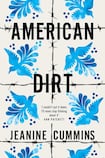
In 2017, when Jeanine Cummins was writing American Dirt, a migrant died every 21 hours along the US-Mexico border. Worldwide that same year, a migrant died every 90 minutes in the Mediterranean, in Central America, in the Horn of Africa. Today, three years later, you need only scan the papers to find stories of “32 Libyans” rescued on the Mediterranean Sea, “60 migrants” intercepted on the English Channel, or “57,000 asylum seekers” waiting on court hearings in Mexican border towns. “But statistics cannot conjure individual human beings,” Cummins says. “I wrote American Dirt because I wanted to access the human story behind the headlines.”
My God, does this book shake the statistics out of you. It starts with a gunshot – “One of the very first bullets comes in through the open window above the toilet where Luca is standing” – and does not let up. It places you right in the heart of the terror and holds your eyes open. Released at the end of January, this might be the first book some people read this year. It might also be the best.
The clear research and heart that went into these pages leave the reader in little doubt about its storyteller
Like many US citizens, Cummins comes from a background “of mixed cultures and ethnicities”. She was born in Spain, but considers Maryland her homeplace. Her grandmother was a Puerto Rican immigrant to US. She has lived in Belfast and her first two novels are set in Ireland. Her husband, a Mayo man, was an undocumented immigrant living in New York when he and Cummins met.
‘Ethnicity and culture’
Nonetheless, as a “non-migrant” and “non-Mexican”, Cummins doubted her credentials to write this book. Many will be glad she forged ahead. The clear research and heart that went into these pages leave the reader in little doubt about its storyteller. Cummins says she drew on her grandmother’s experience of being displaced and misunderstood; her own experience of “ignorance . . . about ethnicity and culture” in mainstream ideas; and – most particularly – a harrowing tale of the rape of two of her cousins in St Louis, to write American Dirt.
The book opens in Acapulco, Mexico, a former tourist haven that is gradually becoming eroded by the presence of Los Jardineros, a criminal gang. Through alternating third-person viewpoints we follow bright, shy, eight-year-old Luca and his charming, romantic, bookseller mother Lydia as they flee their hometown towards the US border. A violent and traumatic opening scene sets them into survival mode. “We’ll have an adventure,” Lydia says to Luca, as they embark, attempting to mask the terror. “Like in the movies?” he asks. “Yes, mijo. Just like in the movies.”
What will happen when the book is released? Will people buy it? Read it? Recommend it for their book clubs?
The structure of the narrative is almost reminiscent of an adventure movie. Two heroes travel across the dangerous and awesome landscape, by foot, by bus, and by jumping aboard la bestia – the freight trains – “like a cowboy riding a bull at the rodeo”. But on this adventure, the monsters feel too real, the stakes too high. Each scene of the book is so detailed and immediate, every threat so unbearable, that the fiction barely feels like fiction at all.
Moving morality
The plot is tightly woven: the narrative tumbling along and the backstory (about Lydia’s life in Acapulco and ties to crime boss La Lechuza) creeping up behind like a terrifying stalker. But it is the strong and memorable characters that are the book’s forte. I loved Lydia, her kindness, her resilience, her mothering nature. I loved Luca’s smarts (he’s a geography ace with “perfect direction the way some prodigies have perfect pitch”) and his bravery. I was moved by the morality of Sebastian, Lydia’s husband, a journalist who dies practising freedom of the press. These are good people. They subvert what some think they know about migrants, and speak to our humanity.
If American Dirt is an “important book” – and I think it is – what makes it so? What will happen when the book is released? Will people buy it? Read it? Recommend it for their book clubs? Will Barack Obama include it in his Favourite Books of 2020? Perhaps.
But the great challenge for a book like this is to drive us to act. To compel us, like the people on the side of the road in Guadalajara handing out “little, white paper bags” of Hersheys; or the doctor stopping his car at night with a jug of water, saying “Please . . . let me help”; or the man in El Verde fixing a “cowboy hat over his bald head” and announcing “I will walk with you”, to reach out a hand: to see these characters, and these statistics, as human beings. I hope we will.









